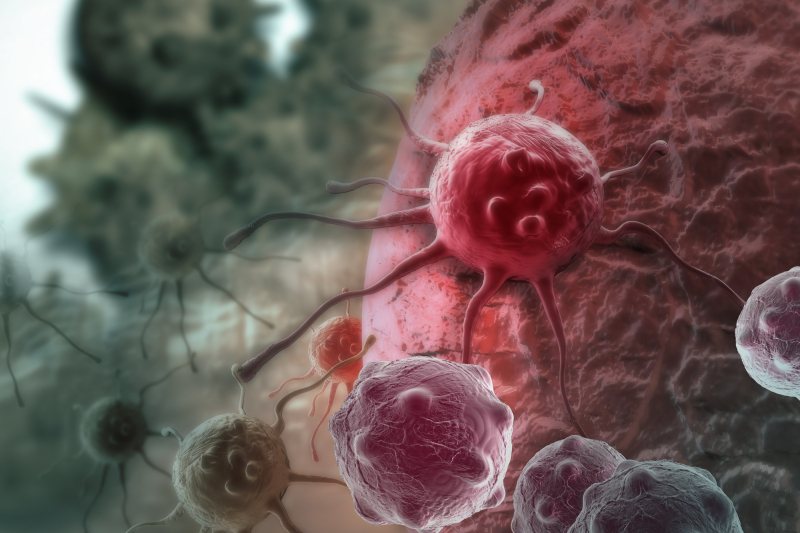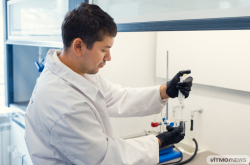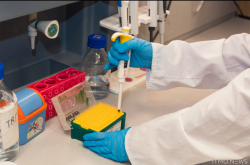Cancer
Cancer is a disease of multicellular organisms – that is, it needs cells to multiply in order to spread in a body. While healthy cells help living organisms function properly, tumor cells, on the contrary, rebelliously break the rules of the game and affect one’s health by expanding within its nearby environments.
Causes of cancer
The main cause of cancer is mutations in the DNA or changes in the sequence of DNA nucleotides, with oncogenes and oncosuppressors being most tied to the disease. Mutations result from a range of factors that include smoking (lung cancer), drinking, and chemical exposure (liver cancer).
That said, mutations can sometimes appear due to an error occurring during cell division. The longer a cell lives and divides, the more likely it is to accumulate cancer-inducing mutations. That is partially why the risk of getting cancer increases with age.
Oncogenes are mutated genes that have the potential to cause cancer. Proto-oncogenes are normal genes that, when mutated, become oncogenes. Tumor suppressors are genes that encode proteins that act to block cells from turning into cancer by regulating their growth and replication. If mutations occur in both a proto-oncogene and a tumor suppressor, the cell becomes more vulnerable to cancer.
To get a better illustration, let's compare cell division to a moving car. If so, oncogenes are a gas pedal that got stuck due to a breakdown (a mutation), causing a car to get out of control regardless of whether the driver presses the pedal or not. Tumor suppressors act as brakes, but they eventually break due to high load. If a car loses both brakes and accelerator pedal, a catastrophic collision cannot be avoided.
Characteristics of tumor cells
In 2000, biologists Robert Weinberg and Douglas Hanahan published an article entitled The Hallmarks of Cancer that describes the crucial features and functions that distinguish cancer cells from normal cells.
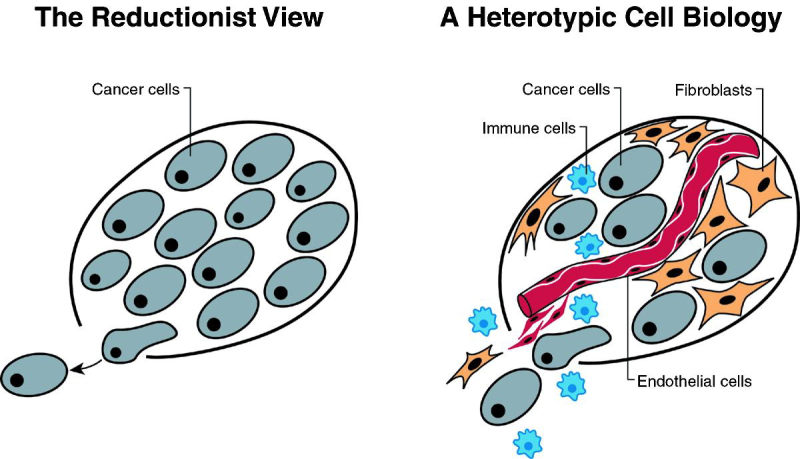
An illustration from Robert Weinberg and Douglas Hanahan’s paper in Cell. The researchers suggest considering tumor cells as complex tissues in which mutant cells have conscripted and subverted normal cell types. Credit: cell.com
Self-sufficiency in growth signals. Normal cells need external signals to start division, which can be transmitted by molecules or hormones that stimulate cell receptors to turn on or off a certain gene. Cancer cells, on the other hand, can produce such signals on their own, for instance, via autocrine signaling (cancer cells independently produce hormones and other chemical substances needed to grow and divide) or paracrine regulation (cancer cells synthesize growth factors with the help of nearby cells and change their behaviors). Tumor cells can also affect signaling proteins: they can modify them so that they no longer need their activation receptors and can transmit signals despite any unfavorable environmental or growth factors. At the same time, different types of cancer come with their own unique sets of genetic alterations.
Insensitivity to anti-growth signals. If a DNA cell is severely damaged, protein suppressors, which are capable of processing internal and external signals about the condition, enter the scene. The p53 gene is the most frequently mutated gene in human cancer, indicating that it plays a crucial role in identifying cancer formation. If the gene detects a damaged nucleotide, it transmits a signal to the latter to stop the cell cycle, thus preventing a cell from further reproduction; otherwise, the cell will continue to replicate, potentially with mutations. In order to survive, a tumor cell acts on protein suppressors to make them mutate or reduce their number, which allows it to ignore signals meant to stop its division.
Evasion of apoptosis. Cancer cells can evade apoptosis – the mechanism that programs cell death once cells become damaged – by causing the p53 to mutate and acquire new oncogenic features.
Limitless replicative potential. The average eukaryotic cell divides between 50-70 times before it dies. As the cell divides, its chromosome gets shorter at telomeres – the regions on its ends that act as sort of caps that protect chromosomes. Telomeres ensure that chromosomes do not get damaged or stick together. With each round of cell replication, telomeres get shorter and shorter until they're so short that they disappear, which activates the cell’s death.
Cancer cells have the ability to reverse telomere shortening by expressing a special enzyme, telomerase, that extends the telomeres of the chromosome and thus makes the cancer cell immortal. Telomerase barely shows any activity in healthy somatic cells yet is produced in cancer cells that have undergone a certain division path. Due to this, cancer cells exhibit a limitless replicative potential.
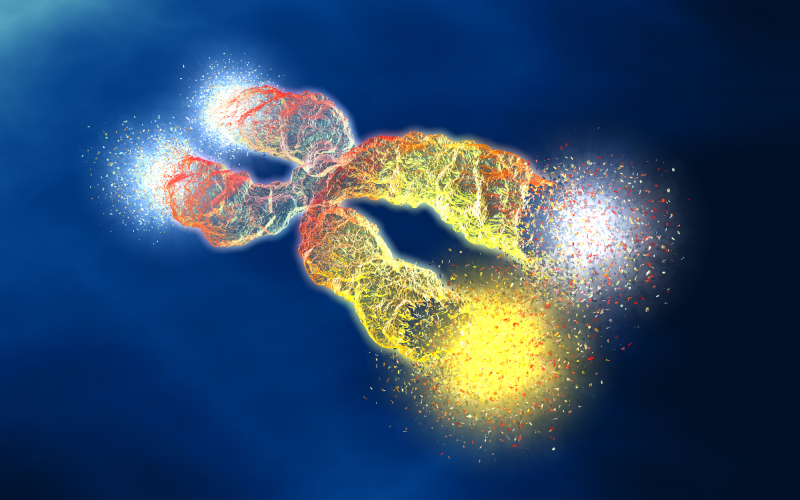
A 3D model of a chromosome with telomeres at its ends. Credit: Axel Kock / photogenica.ru
Sustained angiogenesis. Angiogenesis is the process of new blood vessels forming in an organism or an tissue. Blood vessels have a complex structure and their production calls for resources and a specific sequence of events. As per rule, cells trigger angiogenesis when they receive signals from the intercellular space that vessels are needed, for instance, in case of embryonic development, wound healing, or menstrual period. Tumor cells learn to hack these signals, so that new vessels appear in places of their accumulation, thus providing a steady flow of oxygen and other nutrients to a growing tumor.
Tissue invasion and metastasis. Cancer cells can also invade neighboring tissues and even travel to other parts of the body. To do that, a tumorous cells has to enter the nearby tissues, undergo an epithelial-to-mesenchymal transition (lose their epithelial features, change their shape, etc.), invade the neighboring tissue through the basement membrane, and then move into the blood vessels and further to other organs where they will start to duplicate. The path is not easy so only the most malignant make it through.
Later on, the hallmarks of cancer were increased from six to ten main capabilities of cancer cells.
Research breakthroughs
Surgery, chemotherapy, and radiation therapy are the most-common methods used to treat cancer. Nevertheless, along with killing cancer cells with various chemical and physical agents, chemo- and radiation therapies can damage healthy cells, including epithelial and blood cells. To protect normal cells, researchers developed a new treatment that targets the structural properties of tumor cells.
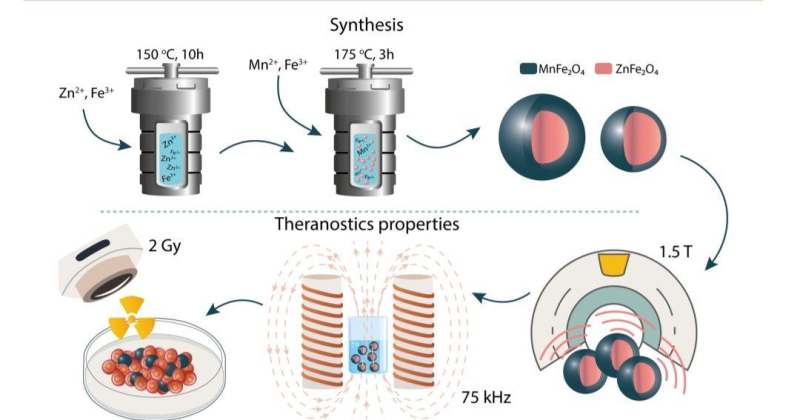
A novel nanoparticle-based approach to cancer treatment and diagnostics proposed by ITMO researchers. The image illustrates nanoparticle production stages. First, in the course of two-stage hydrothermal synthesis, the researchers acquired core-shell magnetic particles. Then, they analyzed the particles’ contrasting capacities, as well as their ability to heat up in the magnetic field and amplify X-ray radiation for diagnostics and treatment. Credit: pubs.rsc.org
Put an uncontrolled division to an end. One of the triggers of breast and stomach cancers is the HER2 receptor, which makes cancer cells grow and divide when activated. In order to block the receptor and stop cell replication, scientists make use of targeted cancer drugs, such as Trastuzumab. The medication contains special proteins that bind to the receptor, leaving it out of nutrients and suppressing incoming signals.
Regain control over the cell cycle. In an effort to prevent cancer cells from replicating forever, scientists use cyclin-dependent kinases inhibitors. These are proteins which suppress the production of enzymes that regulate the cell cycle. For example, when treating breast cancer scientists inhibit the production of CDK 4/6, which is responsible for initiating the replication of cancer cells. Pre-clinical trials show that inhibiting both CDK 4/6 and ER signal pathways brings to a stop the growth of breast cancer cells in the first phase of their cycle.
Read also:
ITMO Scientists Suggest Novel Nanoparticle-Based Cancer Treatment
Enhance apoptosis. Another treatment option is to use pro-apoptotic protein mimetics – drugs that suppress the proteins that prevent cancer cells from dying. For example, scientists have already developed a molecule that imitates the behavior of the protein BH3. It regulates another protein, BLC2, which impacts the degradation rate of malignant cells. Thus, BH3-mimetics can be used to destroy tumors. Such drugs are already utilized in treatments of various types of leukemia.
Inhibit angiogenesis. This method focuses on blocking angiogenesis, which is stimulated by VEGF, a signaling protein that is produced by tumor cells to initiate vessel growth. The activity of this protein can be inhibited via:
-
affecting either the VEGF protein or its receptor with another protein in such a way that the VEGF protein or its receptor can no longer link up one another and therefore transmit signals for angiogenesis. This can be performed using neutralizing monoclonal antibodies, i.e. medications, which selectively block molecular targets that provoke the tumor process.
-
synthesizing proteins similar to VEGF receptors to bind a portion of the VEGF protein existing in the intercellular space. This way, fewer VEGF molecules will reach the receptors, resulting in a weaker signal for vessel creation.
Based on Evgeniya Platonova’s lecture How Cancer Begins, which took place at Planetarium No. 1 library this March.
